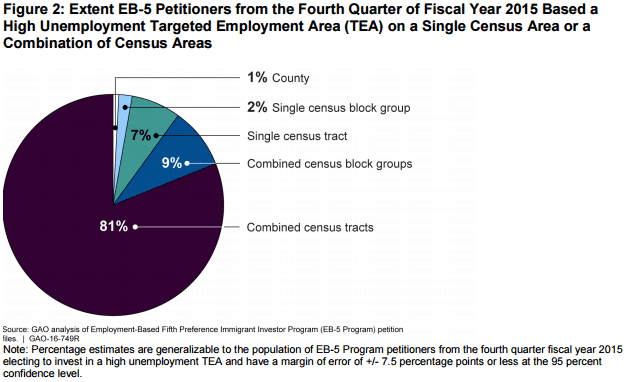The Government Accountability Office (GAO) released a report on October 20 which examines the use of Targeted Employment Areas (TEAs) in the EB-5 Immigrant Investor Program. This report was completed at the request of the Chairmen and Ranking Members of the Senate and House Judiciary Committees. The report analyzes I-526 petitions filed in the 4th quarter of fiscal year 2015 and found that 99% of petitions elected to invest in a project located in a TEA.
The report delves further into types of projects invested in and rate of unemployment in the actual project area. Available on iiusa.org is a mapping tool that presents a policy proposal for TEA reform that borrows from existing federal economic development policy and allows for an objective approach for using them.
Read the Report
From the Report:
“You asked us to provide information on projects that prospective immigrant investors (petitioners) included with their Form I-526 petition for participation in the EB-5 Program. This report provides information we gathered and reviewed from unadjudicated Form I-526 petitions as well as associated documents submitted during the fourth quarter of fiscal year 2015 that describe the (1) proportion of petitioners that did or did not elect to invest in a TEA; (2) proportion of petitioners basing a high unemployment TEA on various types of geographic areas; and (3) EB-5 investment as a proportion of the total investment in petitioners’ TEA projects.
As USCIS does not track information on projects that petitioners included with their Form I-526, we selected and reviewed a simple random sample of 200 of the 6,652 Form I-526 petitions submitted by petitioners to participate in the EB-5 Program in the fourth quarter of fiscal year 2015, from an electronic list USCIS provided of all fiscal year 2015 petitions. We focused our review on petitions filed in that timeframe because of the comparatively larger volume of petitions submitted in the fourth quarter (47 percent) and because those petitions had not yet been adjudicated by USCIS at the time of our review, making them still available for our review. Unless otherwise noted, our sample of 200 petitions allowed us to generalize the results of our review to the universe of 6,652 petitions filed in the fourth quarter of fiscal year 2015 with a confidence interval of +/- 7.5 percentage points or less for percentage estimates at the 95 percent confidence level. For estimates of means and medians, the 95 percent confidence interval is within +/- 13 percentage points or less.”









